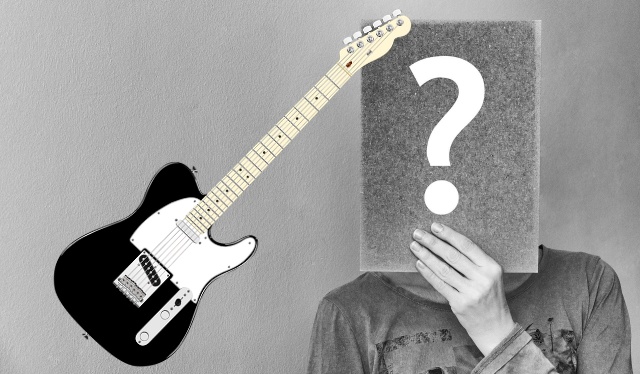
Choosing your first electric guitar can be a daunting task.
Thankfully, helping people find what they need at a price they can afford is something I love to do!
As with any gear acquisition, we must first ask ourselves a few questions.
Answering these questions will help us fulfill our needs and can then direct us to our wants.
Disclaimer: I’ve included the specifications and considerations that I feel are important when looking for a beginner guitar.
There are certainly more things to think about, but none that will substantially alter your decision making process at this stage of development.
With that in mind, let’s dive right in!
What’s your guitar budget?
Don’t break the bank on your first electric guitar. Trust me, I’ve been there.
If you’ve been playing acoustic guitar for years, then there might be more of an argument to drop considerable quantities of cash on your purchase.
But make no mistake, your first electric is where you find out what you love and don’t love about amplified guitar playing.
I suggest staying under $700 for your first electric guitar.
However, there are a plethora of fine guitars to be had at prices that are a fraction of that cost.
A good rule of thumb for purchasing a brand-new electric guitar is to go $200-$500(before any discounts) when you’re just getting into the game.
What type of music do you like to play?

Before we move on, I must say, you can literally play any genre of music on any model of guitar.
HOWEVER, there are certain models with certain specifications that play some genres better than others.
With that in mind, let’s see which guitars facilitate certain popular genres of music.
Metal/Hard Rock
If you’re going to be focusing on learning as much Black Sabbath and Iron Maiden as you possibly can, a guitar with two medium to high output humbuckers is what you’re looking for.
These two bands are considered to be in the “Metal” genre.
Certain models of guitar lend themselves more to metal than others.
The types of pickups can vary Whether they’re active or passive, single coil or humbuckers, the output being medium to high as previously mentioned is the key.
This will allow you to drive your signal pretty hard, producing considerable amounts of distortion when playing either a clean channel or your drive channel of your amplifier.
Types of guitars that lend themselves well to metal and hard rock are generally all solid-body electrics.
These body styles include Les Pauls, Stratocasters, Explorers, Flying V’s and a handful of odd-shaped guitar bodies.
Even telecasters can play heavy music well, with a few pickup and wiring modifications (here’s looking at you, John 5).
I would stay away from hollow body or semi-hollow body instruments when looking to play metal.
This high-gain style of playing can produce pretty high levels of feedback on stage.
However, Dave Grohl of Nirvana and Foo Fighters fame rocks pretty hard with his semi-hollow ES-335.
Blues
If you’re more interested in the blues, playing music by Eric Clapton, or Stevie Ray Vaughan, then you might be more inclined to go for a guitar with medium output single coil pickups or low output humbuckers.
This will give you a little less distortion from your guitar signal but will add clarity to your sound.
Other notable guitarists to play the blues include John Mayer, Kenny Wayne Shepherd, Joe Bonamassa and Jack White.
If you’re into these players, you’ll find that they use variations of the medium output single coil/low output humbucker criteria with some exceptions.
Most prefer vintage spec’d equipment, which are generally low output pickups.
Blues guitarists tend to lean towards three styles of guitar: Stratocasters, Les Pauls, and SG’s.
However, they are certainly not limited to them. Jonny Lang uses a Telecaster and B. B. King played a modified ES-335.
Country
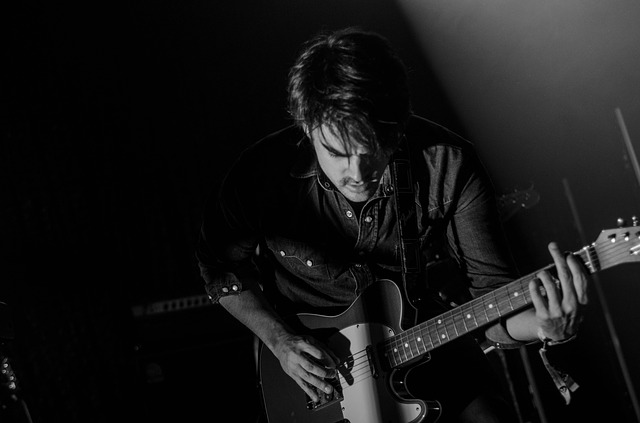
For the backwoods, chicken-pickin types, you’re probably listening to Danny Gatton, Roy Clark, Jerry Reed, Albert Lee and Brad Paisley just to name a few.
Many of these players stayed fairly clean with their signals, only adding grit and distortion naturally from cranked power tubes, a boost and maybe a drive pedal.
Generally speaking, we stick with solid-body guitars here, but there’s definitely room for other options.
If you’re rocking a semi-hollow with a center-block you can get away with it and create some pretty cool country tones.
The telecaster style of guitar and pickup configuration traditionally uses two single coils of low-output design.
However, in recent years, players have begun using humbuckers and increasing the output of their single coils.
Styles of guitar that work well with country and chicken-pickin are of course Telecaster style guitars but additionally Stratocaster styles with three single coils, and various single cutaway style guitars including Les Pauls.
A final consideration is that many country pickers use 9.5” radius guitars.
This is the radius of a modern Fender Stratocaster or Telecaster.
A fun and gritty variation to the single cutaway + two single coils method is a Les Paul with two P-90 pickups.
You’ll get some great twang with a higher output. High-powered country!
Jazz
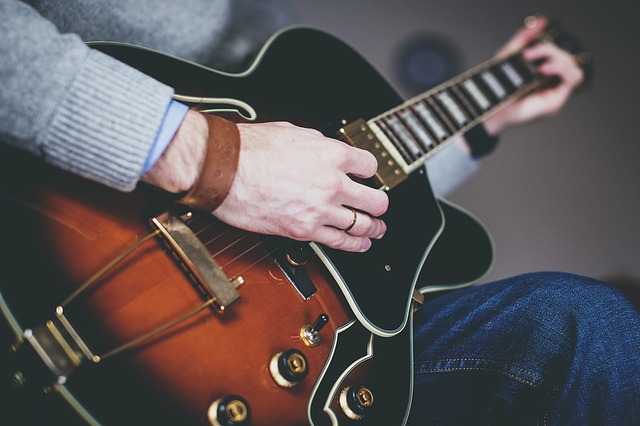
Modern jazz has a few different iterations.
While many still subscribe to the classic hollow-body mantra of guitar selection, others have decidedly gone in different directions, opting for solid body instruments.
I am still personally a fan of the warm, mellow tone one can produce with a single-cutaway hollow-body guitar.
But don’t limit yourself to those choices alone.
When choosing a guitar for that classic jazz sound, my personal opinion is to opt for an instrument with lower output pickups, with preferably a warm humbucker in the neck position.
In other words, one that doesn’t have a high treble response. Additionally, many jazz instruments have rosewood fretboards.
If you’re looking for something with a slightly more modern flair, a double cutaway semi-hollow guitar does very nicely.
It is versatile while retaining a very classic jazz tone.
However, I would be remiss if I didn’t again reiterate that as long as you can play the chord progressions and notes, jazz is a style and can be played on many different types of instruments.
Chet Atkins and Fingerstyle playing
Interestingly enough, fingerstyle pickers in the vein of Chet Atkins also enjoy hollow and semi-hollow body guitars for their exquisite tone and articulation.
Just something to keep in mind, should that be your end goal.
To recap, my main recommendation for jazz and by extension, Chet Atkins fingerstyle, is to be certain that you’re buying a guitar that isn’t going to sound terribly bright.
Hard tail vs. Tremolo electric guitars
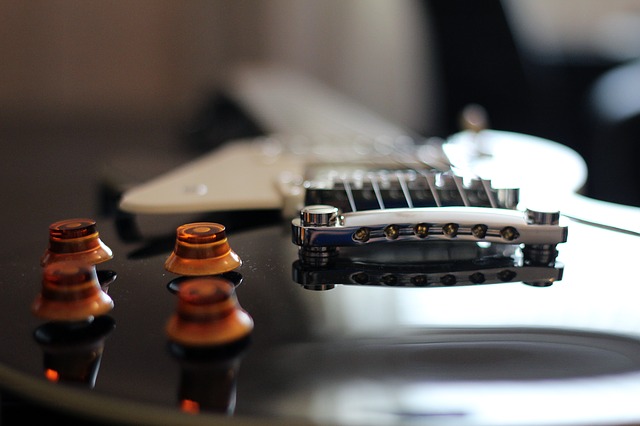
This is an example of one of many traditional hardtail electric guitar bridge setups.
I can’t stress enough that a hardtail is one of the best ways to go if you’re buying your first electric guitar.
It will be very easy to change strings and much better at staying in tune, generally.
Certain tremolos can work, but not all of them.
Additionally, tremolos need to be properly set up or the player may suffer as the tremolo can sit high and impede playability, in my opinion.
Floating and locking tremolo systems
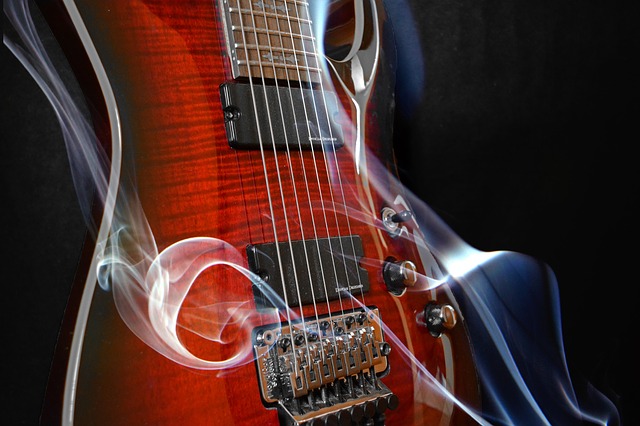
This is a locking, floating tremolo that I do not recommend for beginner guitarists. (of a Floyd Rose style)
I am squarely against beginners or even intermediates without knowledge of guitar setups owning locking tremolos.
This is nothing personal. These Floyd Rose and Kahler style tremolos are generally much more difficult to change strings and are extremely difficult to initially tune.
The issue with locking tremolo systems is derived from the fact that these tremolos require allen wrenches to change the strings.
Additionally, these bridges generally operate in a “floating trem” mode, which means they don’t sit against the body of the guitar.
Essentially, your strings and the springs on your tremolo are striking a balance between themselves to keep the bridge in position.
To sum it up, you must maintain this balance while tuning your guitar, and this can require adjusting previously tuned strings up or down to balance the tension and modify any string that is out of tune.
It’s a hassle that is worth it if you use it all the time but is not worth the gripe if you’re just starting out on the guitar.
Traditional tremolos
This is a traditional 6-point tremolo system.
Traditional tremolos are much easier to use than floating tremolos.
They don’t have a locking nut, which means they’re infinitely easier to tune.
If a beginner student of mine wants a tremolo, I always suggest this style of tremolo.
Additionally, find one that sits flat against the top of the guitar body, such as a Fender style 6-point tremolo.
Bigsby tremolos are not bad options as they’re still easier to tune than locking, floating tremolos.
However, if your guitar happens to have a lower quality model Bigsby-styled tremolo, they will still go out of tune relatively often.
Roundup
Suffice it so say, for beginner guitar players, I suggest getting hardtail style guitars or guitars with tremolos that sit flat against the body of the instrument.
Tuners/tuning machines and tuning
Tuner quality will be mediocre to very good on most guitars in this price range.
I personally prefer instruments with locking tuners thanks to their ability to perform very quick re-strings.
They also tend to help my guitars stay in tune better.
However, the most important way to help your guitar stay in tune is with proper string winding around the posts of your tuning machines(especially on guitars without locking tuners).
This article isn’t necessarily about proper stringing of your instrument, but I will say that 6 in-line tuners tend to hold their tune better than 3+3 styles of tuning machines IN THIS PRICE RANGE.
This is not universal as there are certain guitars that tend to stay in tune well with 3+3 style tuners, but in my travels, 6 in-line tuners tend to stay in tune better.
The nut
If you have the option to get either a bone nut or a graphite or graphite impregnated nut, do it.
There’s no question about it. These two options, if properly set up, will undoubtedly help your guitar stay in tune better.
Other options may not hurt you, but these two suggestions will certainly help you.
What about electric guitars and tone wood?

At this stage of the game, don’t worry about what type of wood the body or neck are built from, unless it is an extremely low-quality wood.
The actual wood type will not make a difference for you at the moment.
We can save that for later, when you’re ready to get yelled at and have your entire life’s choices questioned by the angry hordes of the internet.
I’m cracking a joke, but believe me, there are many people who feel very, very strongly about this topic and while it can be important, it’s not something that will substantially change your playing experience as a beginner, so let’s just move on.
Active vs. passive electric guitar pickups
I like simplicity, so active pickups don’t get the nod from me here.
Sure, all you’re doing is having to change out a 9 volt (or 2) every other month or so, but passive pickups don’t require any batteries and that’s one less thing to worry about.
Again, let’s play for a while and learn as much as we can. Once you hit the intermediate stage, then we can decide on active vs. passive pickups on our electric guitars.
String gauges for electric guitars
Which string gauge you use is something that isn’t going to matter a great deal UNLESS you really want to play large string bends.
The heavier the gauge, the more finger strength you will need for bends.
With that said, 11 and 12 gauge string sets are normally a bit beefy for my students learning to bend their guitar strings.
All things considered, I would suggest 9 and 10 gauge string sets unless your dream is to be a jazz player.
In that case, 11 and 12 gauges aren’t out of the question and you’ll likely be using flatwounds anyway.
For more information on choosing electric guitar strings, check out our guide here.
Get a professional luthier set up
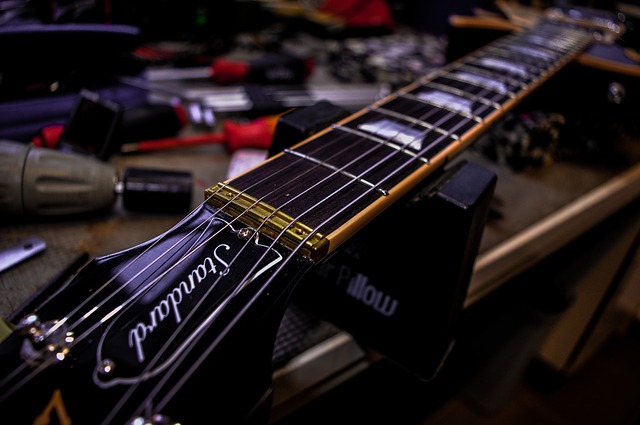
When you’ve received your instrument, I highly suggest getting a professional set up.
Unless you’re playing slide guitar, just tell the guitar tech that you want “action as low as possible without any fret buzz.
Roundup
There are other considerations when choosing your first electric guitar, but in many cases, they are either academic, or not monumental enough to warrant a section here.
We will dive deeper into the finer points of guitar selection as you grow in your skills.
If you have any questions, feel free to message me on our Facebook page @musilesson.
Now that we’ve gone through some of the questions we need to ask ourselves, let’s find some solid selections to help us make beautiful music.
Yamaha Pacifica PAC 112V
Available in a large number of colors, pickup configurations, body materials, and hardtail or tremolo, this Stratocaster style guitar is as varied as it is versatile.
It can be found with either humbuckers, single coils, or both and is suitable for many genres of music ranging from country to metal.
Remember, there are certain configurations that lend themselves better to one style over another, so choose wisely.
The Pacifica range of instruments has gotten great reviews all around.
You will be hard pressed to find an instrument that plays as well as the Pacifica at its various price points (depending on the amenities you choose on the guitar).
However, it is also one of the least known brands on our list and therefore suffers from lack of recognition.
The PAC 112V is truly a jack of all trades, and that’s a great thing.
With its humbucker-single coil-single coil (H-S-S) pickup configuration and split coil technology, you can easily cover clean country and jazz all the way to high gain riffage and singing lead lines with the bridge humbucker.
Additionally, you’ll be able to get the classic Stratocaster triple single coil quack with this configuration.
You’d be hard pressed to find a style of music you can’t at least facilitate with this instrument.
Still, the purest of pure jazz cats may still prefer the warm neck humbucker tone of hollow or semi-hollow body guitars.
If you have the chance, I highly recommend trying out the Pacifica.
Remember, always try to go with a vendor that allows 14-day return policies if possible.
A 7-day return policy is a little short and I don’t feel it properly protects the buyer.
However, the final decision is ultimately up to you.
Great for: crisp clean folk and jazz, country, surf rock, blues, classic rock, hard rock, alt rock, punk
Works for: Metal of most kinds
Not great for: Very little. This instrument is quite versatile.
G&L Tribute ASAT Deluxe Carved Top
This guitar is one of my favorites for various reasons.
But first, I have to specify that it approaches our original $500 goal.
After taxes, you’ll probably be spending more than that, but still well below my suggested $700 limit for purchasing a beginner electric guitar.
With that said, this ASAT Deluxe is a no-brainer when it comes to quality, versatility, and tone.
For those who aren’t familiar, G&L is the third company(Fender, Music Man and finally G&L) Leo Fender of Fender guitars fame started or helped start.
In the eyes of some guitarists, it is the ultimate Fender form and function.
This tribute ASAT Deluxe is no exception.
The ASAT is a Telecaster style guitar, but it transcends its brethren’s capabilities by employing several specifications all its own.
First, the bridge is set almost an inch into the body which helps transfer the vibration of the strings more thoroughly through the body, increasing sustain.
Additionally, there is a pin lock system in the bridge that locks the saddles in place, also increasing sustain and tone.
The ASAT Deluxe bears my main suggestion: It’s a hardtail bridge.
This makes for easy string changing and increased tuning stability.
If you’re a beginner electric guitar player, believe me when I say you’ll appreciate this.
Another great feature is the G&L Paul Gagon designed humbucking pickups.
These pickups tend to be articulate with good low end and noticeable high end frequencies.
This means that you’ll have a beefier telecaster tone with more bottom end, great for everything from hard country to rock and metal.
These pickups also split to single coils, so you can even get some old-school telecaster tones.
I can personally recommend this for someone who plays jazzier blues as well.
This pickup configuration comes much closer to traditionally jazzy warm, mellow tones when using the neck humbucking pickup.
Purists may still scoff here, but those who want versatility will greatly enjoy the flexibility you have with this guitar’s pickups.
Tuning stability, a comfortable satin neck, 22 frets, extreme tonal versatility, and G&L quality make this guitar an amazing buy at this price point.
Even if it takes you an extra month to save up the money, this guitar is well worth the wait for what you’re getting.
I highly recommend it.
Great for: country, jazz, blues, classic rock, hard rock, alt rock, grunge, punk
Works for: Metal of most kinds
Not great for: Not much. The versatility on this guitar is excellent.
Ibanez Artcore AS73
When it comes to semi-hollow guitars within our price range, I’ve been hard pressed to find a better option than the AS73.
There are a handful of models in this range that do a fairly good job with quality and sound, but for my personal tastes, this particular Ibanez model stands just a bit taller.
For starters, this instrument is rocking a medium sized neck. It’s not too thick and not too thin.
Sort of what I call the “Goldilocks” neck size. Some jazz boxes carry thick necks and that’s just not my bag.
Additionally, I enjoy the upper fret access.
One of the reasons I don’t often choose a single cutaway hollow body is due to the fact that I can’t as easily reach the 22nd fret.
For a guy who uses that upper register often, it’s frustrating.
I very much appreciate the all-maple body and mahogany neck.
It’s the perfect balance of warmth and snap. This is accentuated by the Elite pickups Ibanez has installed in each guitar.
These pickups are nice and warm at the neck with some extra snarl at the bridge.
I find the AS73 to be fantastic for everything from jazz to hard rock. Literally, everything.
There’s an argument to be made for swapping out pickups and perhaps upgrading your tuners down the line.
For the price, you’ll be able to afford these changes should you so choose.
The reason for the pickup swap would be if you wanted to play ultra-high gain riffage.
The pickups installed get a tad muddy when you get into Lamb of God and Rammstein territory.
A final note on these guitars concerns the string gauge they ship with.
Normally, they are sent with a 10-52-gauge set, which amounts to a heavy bottom set.
Some players find that if you use lighter strings gauges, the intonation gets a little wonky.
If you’re planning to play jazz, this isn’t a concern. Stick with the gauge it comes with and it won’t be a problem.
If you want to be able to bend much easier, go with a 10-46 gauge set and have a professional luthier set up your guitar.
After that, you’ve got a sweet bending, hard rocking solo machine. Enjoy!
Great for: Jazz, blues, classic rock, alt rock, grunge
Works for: surf rock, hard rock
Not great for: Metal of most kinds
Squier by Fender Classic Vibe 50’s Stratocaster
The Classic Vibe series has become a mainstay in the economy line of Fender guitars, and for good reason.
Everything about these guitars is quality. No matter which type of Classic Vibe you buy, few of them are duds.
Their quality control is actually quite admirable.
When it comes to playability, the neck on the 50’s Classic Vibe is comfortable.
It’s in the “Goldilocks” range for me as well. This guitar is great for playing clean country, blues, classic rock, and some hard rock as well as surf rock.
Though this guitar has a tremolo, it’s a vintage style trem that sits flat against the body, thereby helping to keep the tuning stable.
This affords the beginning player some flexibility with “whammy” tricks but doesn’t make it hard to re-tune.
The pickups in the 50’s classic vibes are on the low-output side, which means they are quite usable for jazz, but not as thick as I personally like for that style.
Still, there’s plenty of versatility to be had here when it comes to genres.
The hundreds of positive reviews and the accolades of many of my students, these Classic Vibe guitars are affordable, durable, and full of tone.
Picking one up is rarely a mistake.
Great for: Clean folk and pop, country, surf rock, classic rock, jazz, punk, alt rock, grunge, blues
Works for: hard rock
Not great for: Metal of most kinds
Schecter Omen-6 6-String Electric Guitar
First, I’m a big fan of Schecter guitars. I love their body shape and styling.
In many of their models, they’re similar to the marriage of a Les Paul and a Stratocaster.
This particular model is more akin to a super Strat.
I chose this model for the list because it’s the quintessential beginner’s guitar for everything from hard rock to doom metal.
I haven’t mentioned anything about fret sizes yet because it’s not normally a consideration when choosing a beginner electric guitar.
But for playing heavy music such as metal, jumbo or even extra jumbo-sized frets become useful because it provides more space between your fingertips and the fingerboard when pressing the strings against the frets.
However, one down side is you are required to play lightly, as playing too heavy will cause your pitches to go sharp.
The benefit here is that less finger against the fingerboard means less drag and also means you can use less pressure while playing and still fret your desired note.
Additionally, the Omen-6 has 24 frets for a full two octave range on each string, often used by players who prefer the high-flying solos and wide-ranging riffage that various genres of metal and hard rock promote.
This guitar is definitely the heaviest hitter gunning for the heaviest music you can throw at it.
With its two high-powered humbuckers, you’ll be able to tackle Iron Maiden and Metallica easily.
But keep in mind, this guitar won’t be quite as versatile as others on this list.
For example, the Omen-6 doesn’t produce the most convincing of country and jazz tones.
All in all, if you’re looking for sonic decimation or would like to start making your way there in your lessons, this is a great guitar to take with you to the starting line.
Great for: hard blues, hard rock, metal of all kinds
Works for: classic rock, alt rock, grunge. blues
Not great for: Country, jazz, or folk
Final thoughts
This is a general guide for choosing the beginner electric guitar that’s right for you.
Remember that every individual is different, and your tastes and needs will vary from the person next to you.
Also remember that each new guitar that you purchase will likely need a professional setup to play its best, with a handful of exceptions.
Take this into account when budgeting for your new electric guitar.
Finally, don’t forget that while I’ve included some great suggestions to complete your guitar search, there are many other great options out there.
I tried to include the body styles and pickup configurations that most of my students choose, but don’t be afraid to look around for the guitar that you think will best serve you.
If you have any questions, feel free to message me on Facebook.
I’d be happy to give you advice! I hope this article has helped you and if it has, feel free to share it with your friends in real life and on social media.
Take care and rock on friends!








